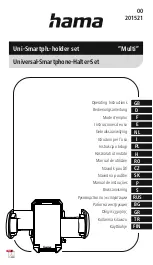
1-5
For Safe Operation
1
Flat Panel Sensors Operation Manual 897N200608
● Immediately stop charging the battery pack, if charging is not completed within the specified
time. Otherwise, the battery pack may overheat, emit smoke, explode or ignite.
● Do not use the flat panel sensor near the power cable.
● Do not use a faulty or broken battery charger or AC adapter.
Battery Pack Instructions
WARNING
● Battery pack requires regular checkup and replacement. Battery capacity begins to wane
after a period of time.
● If this equipment is not in use for while, store it with the battery pack removed. Not
removing the battery pack may cause malfunction.
CAUTIONS
Observe the following precautions when using the battery pack (optional).
● The battery pack is used with the flat panel sensor. Do not use them in other combinations.
● Charge the battery pack only with the designated battery charger. If the battery pack is
charged under the charging conditions (voltage, current and charging method) different
from those specified by INNOLUX Corporation, the battery pack may emit smoke, ignite,
explode or leak fluid.
● Store the battery pack in a cool and dark place. Recharge the stored battery pack every six
months or every year. Otherwise a decrease in battery capacity or other problems may result.
● Do not leave the removed battery pack in the car or other places exposed to high
temperature. If the battery pack is used or stored in a place where it is exposed to high
temperature, the battery pack may emit smoke, ignite, explode or leak fluid.
● Use or store the battery pack only in the environmental conditions specified by INNOLUX
Corporation. If the battery pack is used or stored in a place where it is exposed to high
temperature, the battery pack may emit smoke, ignite, explode or leak fluid.
● When disposing of the battery pack, consult our official dealer or INNOLUX Representative.
● Do not disassemble or remodel the battery pack. The battery pack is equipped with built-in
safety and protection mechanisms. If they are damaged, the battery pack may overheat, emit
smoke, explode or ignite.
● Be careful not to drop the battery pack. The patient may be injured.
● Do not touch the terminal of the battery pack directly. There is a risk of electric shock.
● Do not connect the positive (+) and negative (-) terminals with a wire or any metal object.
Do not carry or store the battery pack together with metal objects such as necklaces or
hairpins. Otherwise, the battery pack may short-circuit and overcurrent may flow, causing
the battery pack to overheat, emit smoke, explode or ignite. Metal objects such as necklaces
or hairpins may also become hot.
● Do not throw the battery pack into fire or expose it to excessive heat. Otherwise, its insulator
may melt, its gas release vent or safety mechanisms may be damaged, and/or its electrolyte
may catch fire, causing the battery pack to overheat, emit smoke, explode or ignite.
● Do not use or leave the battery pack in a place where it is exposed to high temperature (80°C
or higher), such as fire or a heater. If the resin separator is damaged due to heat, the battery
pack may short-circuit, causing it to overheat, emit smoke, explode or ignite.
● Do not immerse the battery pack in water or seawater, and do not allow it to become wet.
If the built-in protection mechanisms are damaged, the battery pack may overheat, emit
smoke, explode or ignite.
● Do not pierce the battery pack with a nail, hit it with a hammer, or step on it. Otherwise, the
battery pack may be damaged or deformed and short-circuit, causing it to overheat, emit
smoke, explode or ignite.
● Do not subject the battery pack to strong impact or throw it. If the built-in protection
mechanisms are damaged, the battery pack may be charged with extremely high current and
voltage, and abnormal chemical reactions may occur inside the battery pack, causing it to
overheat, emit smoke, explode or ignite.











































